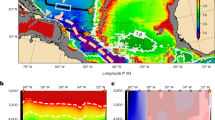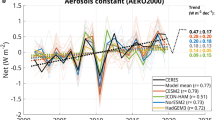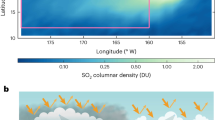Abstract
Ice sheets may have reached the Equator in the late Proterozoic era (600–800 Myr ago), according to geological and palaeomagnetic studies, possibly resulting in a ‘snowball Earth’. But this period was a critical time in the evolution of multicellular animals, posing the question of how early life survived under such environmental stress. Here we present computer simulations of this unusual climate stage with a coupled climate/ice-sheet model. To simulate a snowball Earth, we use only a reduction in the solar constant compared to present-day conditions and we keep atmospheric CO2 concentrations near present levels. We find rapid transitions into and out of full glaciation that are consistent with the geological evidence. When we combine these results with a general circulation model, some of the simulations result in an equatorial belt of open water that may have provided a refugium for multicellular animals.
This is a preview of subscription content, access via your institution
Access options
Subscribe to this journal
Receive 51 print issues and online access
$199.00 per year
only $3.90 per issue
Buy this article
- Purchase on Springer Link
- Instant access to full article PDF
Prices may be subject to local taxes which are calculated during checkout





Similar content being viewed by others
References
Hoffman, P. F. Did the breakout of Laurentia turn Gondwanaland inside-out? Science 252, 1409–1411 ( 1991).
Dalziel, I. W. D. Overview: Neoproterozoic-Paleozoic geography and tectonics: Review, hypothesis, environmental speculation. Geol. Soc. Am. Bull. 109 , 16–42 (1997).
Knoll, A. H. & Walter, M. R. Latest Proterozoic stratigraphy and Earth history. Nature 356, 673– 678 (1992).
Hoffman, P. F., Kaufman, A. J., Halverson, G. P. & Schrag, D. P. A Neoproterozoic snowball earth. Science 281, 1342–1346 (1998).
Christie-Blick, N. Pre-Pleistocene glaciation on Earth: Implications for climatic history of Mars. Icarus 50, 423–443 (1982).
Hambrey, H. A. & Harland, W. B. The late Proterozoic glacial era. Paleogeogr. Paleoclimatol. Paleoecol. 51, 255–272 (1985).
Eyles, N. Earth's glacial record and its tectonic setting. Earth Sci. Rev. 35, 1–248 ( 1993).
Schmidt, P. W. & Williams, G. E. The Neoproterozoic climate paradox: Equatorial paleolatitude for Maninoan glaciation near sea level in south Australia. Earth Planet. Sci. Lett. 134, 107– 124 (1995).
Wray, G. A., Levontin, J. S. & Schapiro, L. H. Molecular evidence for deep Precambrian divergences among metazoan phyla. Science 274, 568– 573 (1996).
Breyer, J. A., Busbey, A. B., Hanson, R. E. & Roy, E. C. Possible new evidence for the origin of metazoans prior to 1 Ga: Sediment-filled tubes from the Mesoproterozoic Allamoore formation, Trans-Pecos Texas. Geology 23, 269–272 ( 1995).
McNamara, K. J. Dating the origin of animals. Science 274, 1995–1996 (1996).
Fedonkin, M. A. & Waggoner, B. M. The Late Precambrian fossil Kimbrella is a mollusc-like bilaterian organism. Nature 388, 868–871 ( 1997).
North, G. R. Theory of energy-balance climate models. J. Atmos. Sci. 41, 3990–3995 (1975).
Crowley, T. J. & Baum, S. K. Effect of decreased solar luminosity on late Precambrian ice extent. J. Geophys. Res. 98, 16723–16732 ( 1993).
Jenkins, G. S. & Frakes, L. A. GCM sensitivity test using increased rotation rate, reduced solar forcing and orography to examine low latitude glaciation in the Neoproterozoic. Geophys. Res. Lett. 25, 3528 (1998).
Jenkins, G. S. & Smith, S. R. GCM simulations of Snowball Earth conditions during the late Proterozoic. Geophys. Res. Lett. 26, 2263–2266 (1999).
Williams, G. E. Late Precambrian glacial climate and the Earth's obliquity. Geol. Mag. 112, 441–465 ( 1975).
Oglesby, R. J. & Ogg, J. G. The effect of large fluctuations in the obliquity on climates of the late proterozoic. Paleoclim. Data Modelling 2, 293–316 (1998).
Deblonde, G. & Peltier, W. R. Simulations of continental ice sheet growth over the last glacial-interglacial cycle: Experiments with a one-level seasonal energy balance model including realistic geography. J. Geophys. Res. 86, 9189–9215 (1991).
Deblonde, G., Peltier, W. & Hyde, W. T. Simulations of continental ice-sheet growth over the glacial-interglacial cycle: Experiments with a one level seasonal energy balance model including seasonal ice albedo feedback. Glob. Planet. Change 98, 37–55 ( 1992).
Tarasov, L. & Peltier, W. R. Terminating the 100 kyr ice age cycle. J. Geophys. Res D 18, 21665– 21693 (1997).
Nye, J. F. The motion of ice sheets and glaciers. J. Glaciol. 3, 493–507 (1959).
Reeh, N. Parameterization of melt rate and surface temperature on the Greenland ice sheet. Polarforschung 59, 113– 128 (1990).
Huybrechts, P. & T'Siobbel, S. Thermomechanical modelling of Northern Hemisphere ice sheets with a two-level mass-balance parameterization. Ann. Glaciol. 21, 111– 116 (1995).
Hyde, W. T.,, Kim, K.-Y., Crowley, T. J. & North, G. R. On the relationship between polar continentality and climate: Studies with a nonlinear energy balance model. J. Geophys. Res D 11, 18653–18668 (1990).
Crowley, T. J., Baum, S. K. & Hyde, W. T. Climate model comparisons of Gondwanan and Laurentide glaciations. J. Geophys. Res D 5, 619– 629 (1999).
Hyde, W., Crowley, T. J., Tarasov, L. & Peltier, W. R. The Pangean ice age: Studies with a coupled climate-ice sheet model. Clim. Dyn. 15, 619–629 ( 1999).
Berger, A. Long-term variations of daily insolation and Quaternary climate changes. J. Atmos. Sci. 35, 2362–2367 (1978).
Bond, G. C., Nickeson, P. A. & Kominz, M. A. Breakup of a supercontinent between 623 and 555 Ma: New evidence and implications for continental histories. Earth Planet. Sci. Lett 70, 325–345 (1984).
Kaufman, A. J., Jacobson, S. B. & Knoll, A. H. The Vendian record of Sr and C isotopic variations in seawater: Implications for tectonics and paleoclimate. Earth Planet. Sci. Lett. 120, 409– 430 (1993).
Baum, S. K. & Crowley, T. J. Seasonal snowline instability in a climate model with realistic geography: Application to Carboniferous (≈300 Ma) glaciation. Geophys. Res. Lett. 18, 1719–1722 (1991).
Crowley, T. J., Yip, K.-J. J. & Baum, S. K. Snowline instability in a general circulation model: Application to Carboniferous glaciation. Clim. Dyn. 10, 363–376 (1994).
Scotese, C. R. & Golonka, J. Paleogeographic Atlas (Technical report, Paleomap project, University of Texas-Arlington, 1992).
Crowley, T. J., Yip, K.-J. J. & Baum, S. K. Milankovitch cycles and Carboniferous climate. Geophys. Res. Lett. 20, 1175–1178 (1993).
Thompson, S. L. & Pollard, D. A global climate model (GENESIS) with a land-surface-transfer scheme (LSX). Part 1: Present-day climate. J. Clim. 8, 732– 761 (1995).
Baum, S. K. & Crowley, T. J. GCM response to Late Precambrian (∼600 Ma) ice-covered continents. J. Geophys. Res. (submitted).
North, G. R. The small ice cap instability in diffusive climate models. J. Atmos. Sci. 32, 1301–1307 ( 1984).
Manabe, S. & Broccoli, A. J. The influence of continental ice sheets on the climate of an ice age. J. Geophys. Res. 90, 2167–2190 (1985).
Hyde, W. T., Crowley, T. J., Kim, K.-Y. & North, G. R. Comparison of GCM and energy balance model simulations of seasonal temperature changes over the past 18000 years. J. Clim. 2, 864–887 (1989).
Jenkins, G. S. A general circulation model study of the effects of faster rotation rate, enhanced CO2 concentration and reduced solar forcing: Implications for the faint-young sun paradox. J. Geophys. Res. 98 , 20803–20811 (1993).
Williams, G. E. Cyclicity in the Late Precambrian Elatina formation, South Australia: Solar or tidal signature? Clim. Change 13, 117 –128 (1998).
Kirschvink, J. L. in The Proterozoic Biosphere (eds Schopf, J. W. & Klein, C.) 51–52 (Cambridge University Press, 1992).
Christie-Blick, N. in Proterozoic to Recent Stratigraphy, Tectonics and Vulcanology, Utah, Nevada, Southern Idaho and Central Mexico (eds Link, P. K. & Kowallis, B. J.) 1–30 (Geology Studies Vol. 42, Part I, Brigham Young University, Provo, 1997).
Paterson, W. S. B. The Physics of Glaciers (Pergamon, Oxford, 1981).
Peltier, W. R. Postglacial variations in the level of the sea: Implications for climate dynamics and solid-earth geophysics. Rev. Geophys. 36, 603–689 (1998).
Tarasov, L. & Peltier, W. R. Impact of thermo-mechanical ice-sheet coupling on a model of the 100 kyr ice age cycle. J. Geophys. Res 104, 9517–9545 ( 1999).
Fairbanks, R. G. A 17,000-year glacio-eustatic sea level record: Influence of glacial melting rates on Younger Dryas event and deep-ocean circulation. Nature 342, 637–642 ( 1989).
Kaufmann, A. J., Knoll, G. H. & Narbonne, G. M. Isotopes, ice ages, and terminal Proterozoic Earth history. Proc. Natl Acad. Sci. USA 94, 6600 –6605 (1997).
Kennedy, M. J., Runnegar, B., Prave, A. R., Hoffman, K. H. & Arthur, M. A. Two or four Neoproterozoic glaciations? Geology 26, 1059–1063 (1998).
Acknowledgements
We thank I. Dalziel and L. Gahagan for the plate reconstructions, and N. Christie-Blick, N. Eyles, I. Dalziel, P. Hoffman, M. Huber, A. Knoll and D. Schrag for comments and suggestions. We thank P. Smith for helping to prepare the cover picture. This research was supported by the National Center for Atmospheric Research, the National Sciences and Engineering Research Council fo Canada, and by the NSF.
Author information
Authors and Affiliations
Corresponding author
Rights and permissions
About this article
Cite this article
Hyde, W., Crowley, T., Baum, S. et al. Neoproterozoic ‘snowball Earth’ simulations with a coupled climate/ice-sheet model. Nature 405, 425–429 (2000). https://doi.org/10.1038/35013005
Received:
Accepted:
Issue Date:
DOI: https://doi.org/10.1038/35013005
This article is cited by
-
Production of Neoproterozoic banded iron formations in a partially ice-covered ocean
Nature Geoscience (2024)
-
Mid-latitudinal habitable environment for marine eukaryotes during the waning stage of the Marinoan snowball glaciation
Nature Communications (2023)
-
Ice-free tropical waterbelt for Snowball Earth events questioned by uncertain clouds
Nature Geoscience (2022)
-
Active methanogenesis during the melting of Marinoan snowball Earth
Nature Communications (2021)
-
Snowfall-albedo feedbacks could have led to deglaciation of snowball Earth starting from mid-latitudes
Communications Earth & Environment (2021)
Comments
By submitting a comment you agree to abide by our Terms and Community Guidelines. If you find something abusive or that does not comply with our terms or guidelines please flag it as inappropriate.



